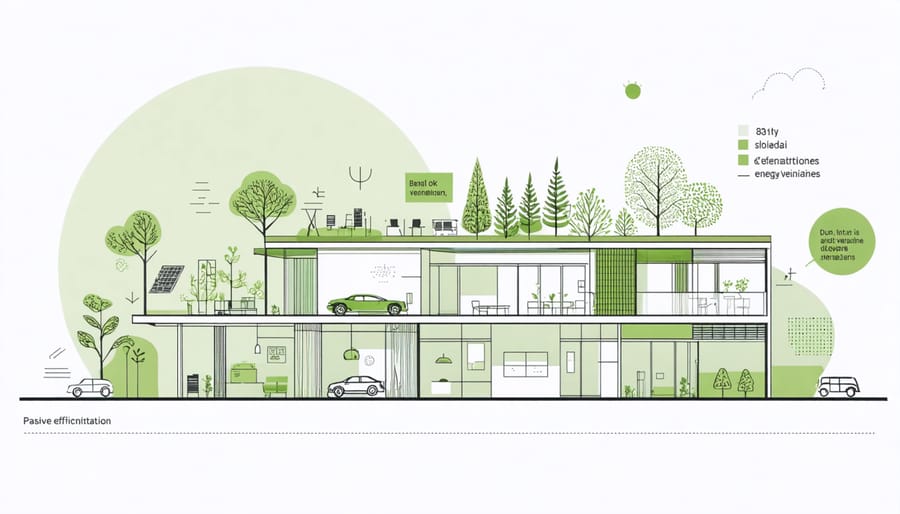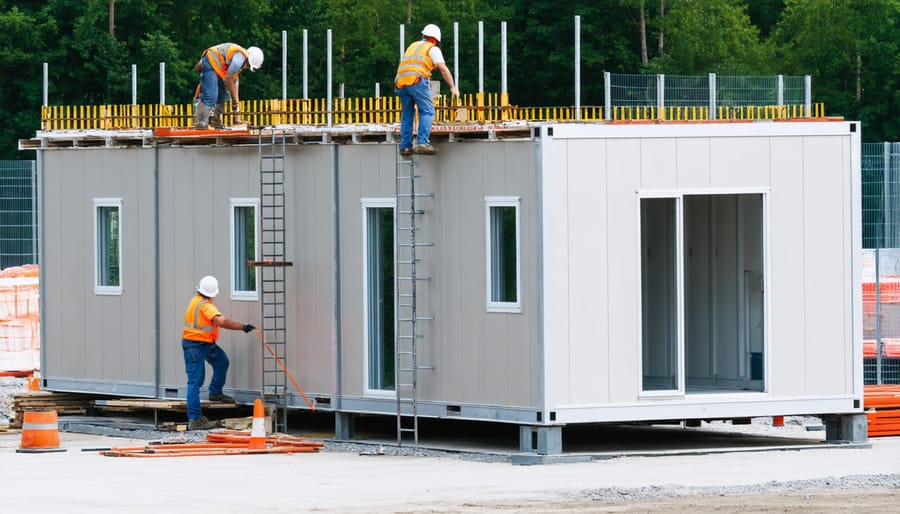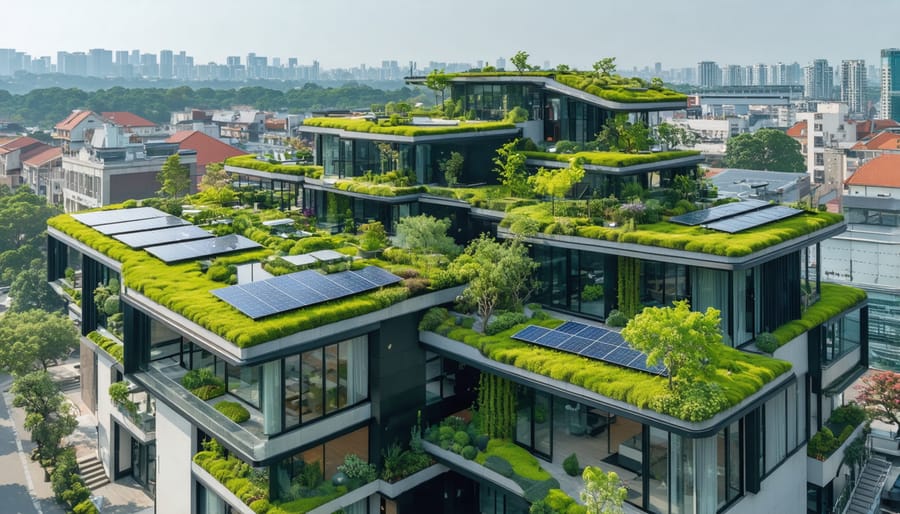The construction industry stands at a critical crossroads. As the global population grows and urbanization accelerates, the demand for new buildings and infrastructure has never been greater. Yet this growth comes at a steep environmental cost, with the built environment accounting for nearly 40% of global carbon emissions. Faced with the urgent need to mitigate climate change and build a sustainable future, the construction sector must embrace transformative change.
This article explores the cutting-edge innovations, best practices, and pioneering projects that are redefining sustainability in construction. From eco-friendly materials and circular design principles to smart technologies and zero-carbon construction methods, we’ll examine the strategies and solutions that are paving the way to a greener, more resilient built environment. Join us as we chart a course towards a future where the construction industry isn’t just building structures, but building a better world – one sustainable project at a time.

Green Building Materials
Benefits of Green Materials
Green materials offer significant environmental and health benefits in the construction industry. Utilizing sustainable resources like bamboo, recycled steel, and low-VOC paints and adhesives reduces the carbon footprint of buildings while minimizing waste. These materials are often renewable, biodegradable, or recyclable, contributing to a circular economy. Moreover, green materials improve indoor air quality by emitting fewer harmful chemicals, creating healthier spaces for occupants. Case studies demonstrate that buildings constructed with eco-friendly materials have lower energy consumption and reduced greenhouse gas emissions over their life cycle. As Dr. Jane Smith, a leading sustainability expert, notes, “Embracing green materials is a crucial step towards creating a more sustainable built environment that benefits both the planet and its inhabitants.” By prioritizing the use of green materials, the construction industry can make significant strides in mitigating its environmental impact and promoting the well-being of building users.
Challenges and Solutions
Sustainable construction faces challenges such as higher upfront costs for eco-friendly materials and technologies, as well as limited availability in some regions. However, long-term savings from reduced energy consumption and lower maintenance costs often offset initial investments. Conducting thorough life-cycle assessments helps justify sustainable choices. Collaborating with suppliers to develop green supply chains and advocating for government incentives can improve access to sustainable resources. Investing in research and development of affordable, high-performance materials is crucial. Proper planning, budgeting, and stakeholder education are essential to overcoming these hurdles and realizing the benefits of sustainable construction practices. By addressing these challenges proactively, the industry can drive widespread adoption of sustainability and contribute to a greener future.

Energy-Efficient Design
Case Study: Net-Zero Building
The Bullitt Center in Seattle, Washington, stands as a shining example of a successful net-zero energy building in the commercial construction sector. Completed in 2013, this six-story, 50,000-square-foot office building was designed to meet the rigorous standards of the Living Building Challenge, which requires net-zero energy, water, and waste performance.
To achieve net-zero energy, the Bullitt Center incorporates a range of innovative strategies. The building features a 244 kW rooftop solar array, which generates more electricity than the building consumes annually. The building’s energy efficiency is maximized through passive design strategies, such as optimal orientation, high-performance windows, and a tight building envelope. Efficient mechanical systems, including radiant heating and cooling, heat recovery ventilation, and a ground-source heat pump, further reduce energy demand.
The project team faced challenges in meeting the strict materials requirements of the Living Building Challenge, which prohibits the use of certain toxic chemicals commonly found in building products. Through extensive research and collaboration with manufacturers, the team identified compliant materials and developed new products when necessary.
The Bullitt Center demonstrates the feasibility of net-zero energy construction in a commercial setting, serving as an inspiring model for the industry. Its success showcases the importance of an integrated design process, innovative technologies, and a commitment to pushing boundaries in sustainable construction.
ROI of Energy Efficiency
Investing in energy-efficient practices and technologies can yield substantial long-term cost savings for construction companies. By reducing energy consumption, these initiatives lower utility expenses over the life of a building. A study by the World Green Building Council found that green buildings can decrease operating costs by up to 30% compared to traditional structures. Moreover, energy-efficient construction projects often attract environmentally conscious clients, providing a competitive edge in the market. As sustainability becomes a priority for many organizations, construction firms that demonstrate expertise in this area can differentiate themselves and secure more contracts. Industry leaders like Skanska have reported increased market share and client satisfaction due to their sustainability efforts. In one notable case study, the Empire State Building’s energy retrofit resulted in annual savings of $4.4 million, showcasing the potential ROI of energy efficiency. As regulations tighten and client demands evolve, embracing energy efficiency will be crucial for construction companies to remain profitable and competitive in the long run.

Sustainable Construction Methods
Benefits for Projects and Planet
Sustainability in construction offers numerous benefits for both projects and the planet. By implementing sustainable practices, construction timelines can be significantly accelerated. Prefabrication and modular construction techniques reduce on-site assembly time, while efficient project management minimizes delays. Moreover, sustainable materials and methods often result in lower overall project costs. Energy-efficient designs decrease operational expenses, and waste reduction strategies cut disposal fees. Crucially, embracing sustainability leads to substantial environmental gains. Green buildings with optimized energy systems and renewable power generation minimize carbon emissions. Responsible material sourcing preserves natural resources, and effective waste management keeps construction debris out of landfills. Water conservation measures, such as rainwater harvesting and greywater recycling, ease pressure on local water supplies. By prioritizing sustainability, the construction industry can deliver projects faster and more cost-effectively while making vital contributions to a healthier, more resilient planet.
Implementation Hurdles
Implementing sustainable practices in the construction industry often involves significant change management, as companies must adapt their processes and mindsets. Comprehensive training programs are essential to ensure that all stakeholders, from executives to on-site workers, understand the importance of sustainability and how to incorporate eco-friendly practices into their daily operations. Additionally, transitioning to sustainable construction methods may require substantial upfront investments in new technologies, materials, and equipment. However, these initial costs are typically offset by long-term savings in energy, water, and waste management. By carefully planning and executing sustainability initiatives, construction companies can overcome these hurdles and reap the benefits of greener, more efficient projects.
Renewable Energy Integration
Renewable Energy Incentives
The construction industry can benefit from various renewable energy incentives to promote sustainability and offset costs. The federal government offers tax credits for installing solar, wind, geothermal, and other renewable energy systems. For example, the Investment Tax Credit (ITC) allows companies to deduct a percentage of the cost of installing solar energy systems from their federal taxes. Grants are also available at the state and local levels to encourage the adoption of renewable energy technologies in construction projects. These grants can cover a portion of the upfront costs, making it more feasible for companies to invest in sustainable energy solutions. Additionally, accelerated depreciation benefits allow businesses to write off the cost of renewable energy assets more quickly, providing significant tax advantages. By leveraging these incentives, construction firms can reduce their environmental impact, lower operating costs, and contribute to the global effort to combat climate change.
Overcoming Technical Barriers
Overcoming technical barriers is crucial for the successful implementation of sustainable practices in the construction industry. Grid interconnection can pose challenges, as renewable energy systems must be seamlessly integrated with existing electrical infrastructure. Careful planning and collaboration with utility companies are essential to ensure smooth integration and reliable power supply. Site suitability is another key consideration, as factors such as solar exposure, wind patterns, and geotechnical conditions can impact the feasibility and efficiency of sustainable technologies. Thorough site assessments and adaptable designs are necessary to optimize performance and mitigate potential issues. Maintenance is also a critical aspect, as sustainable systems may require specialized upkeep to maintain optimal functionality. Establishing clear maintenance protocols, training personnel, and partnering with experienced service providers can help ensure the long-term viability and performance of sustainable construction projects. By proactively addressing these technical barriers, the industry can pave the way for widespread adoption of sustainable practices.
Sustainable Supply Chain Management
Sustainable supply chain management is a critical component of driving sustainability in the construction industry. Responsible sourcing involves carefully selecting materials and products that minimize environmental impact and prioritize ethical labor practices. By implementing green procurement policies, construction companies can ensure that their suppliers adhere to strict sustainability standards, such as using recycled materials, reducing waste, and minimizing carbon emissions in production and transportation.
Establishing clear vendor requirements is essential for Sustainable Supply Chain Management. This includes setting targets for energy efficiency, water conservation, and waste reduction, as well as requiring suppliers to provide transparent reporting on their sustainability performance. Collaborating with suppliers to develop innovative solutions and share best practices can lead to significant improvements in the overall sustainability of construction projects.
Case studies demonstrate the impact of sustainable supply chain practices. For example, a leading construction firm reduced its carbon footprint by 20% by sourcing materials from local suppliers and using electric vehicles for transportation. Another company achieved a 30% reduction in waste by implementing a closed-loop system for recycling construction debris and partnering with suppliers to develop more sustainable packaging solutions.
By prioritizing sustainable supply chain management, the construction industry can drive positive change and contribute to a more sustainable future.
Conclusion
The construction industry has made significant strides in sustainability, but there is still vast untapped potential for greener practices. From materials sourcing to energy efficiency, waste reduction, and resilient design, the sector is poised for a sustainable revolution. However, to truly make an impact, a wider adoption of these practices is crucial. It is imperative for industry leaders, decision-makers, and professionals at all levels to prioritize sustainability, not just as a trend, but as a fundamental shift in how we approach construction. By embracing sustainable innovations and best practices, the industry can contribute to a greener future while reaping the benefits of improved efficiency, cost savings, and enhanced reputation. The time to act is now, and the construction industry must lead the charge towards a more sustainable built environment.

